
Armada de Chile 1947-1990
 c80 ships, 1947-Today
c80 ships, 1947-Today
The Legacy fleet from WW2
Chile stayed neutral in both conflicts, inline with other American states and because of several factors, notably because in WW1 Chile only had a small shipping fleet of just 87 steamers, 33 sailboats, a detail for U-Boats. It was the same in 1940, Von Spee’s squadron was even able to supply in Chilean ports, or taking refuge after the squadron was obliterated. German Merchant ships were however interned. After the hostilities ended some of these ships were either integrated or scuttled.
The most cruel lack of naval power was mostly compared to its neighbour Argentina which had two capital ships, while Chile had nothing but elderly ships, and the museum ship ironclad Huascar. The order of two battleships in 1913 was cut short when the first one was requisitioned by the government, integrated into the RN as HMS canada, and the second proposed postwar and completed as aircraft carrier (HMS Hermes). As a result, Chile had to wait postwar to obtain its only modern capial ship in decades. There was the 1927-1931 naval plan, only one able to restore confidence in the Navy (Latorre modernized in Great Britain, construction of 6 destroyers, 3 submersibles, a sub depot ship and two oilers) just before a mutiny that was lost against the loyal army and air force, political downfall and deconsideration in the general public. In 1945, Chile was not that much powerful, after the 1930s maintenance and budget crisis causing wave of decommissions.
1945 Chilean order of battle
Chilean capital ship: Alm. Latorre
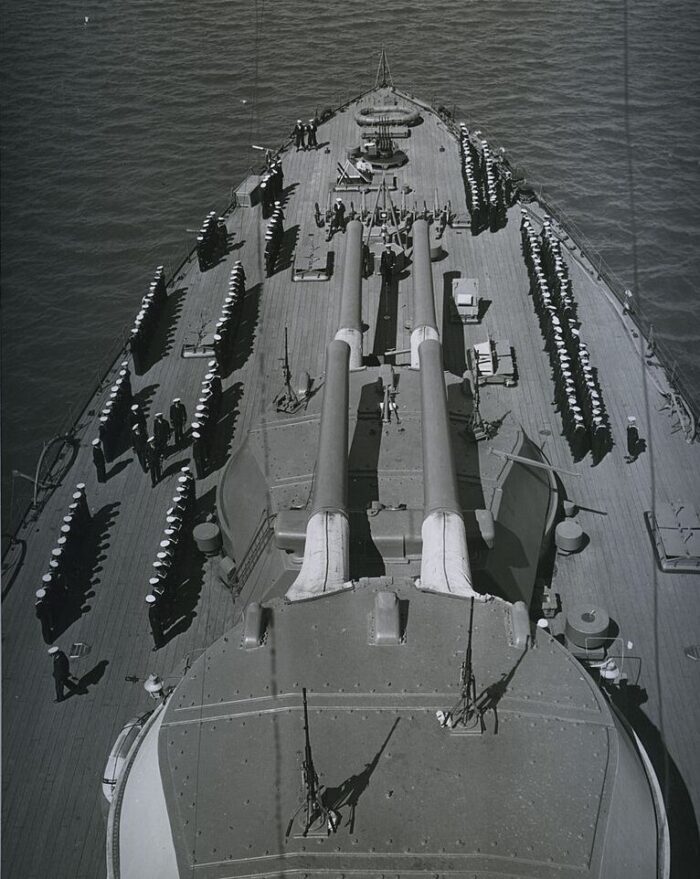
The grand old lady was probably the british-built oldest dreadnought of her generation still around. Modernized in 1930 she was on par with technologies of the time, but a dinosaur at the jet age, lacking radars. But she was kept as a training ship, the only logical choice. In 1949 a report clearly showed the poor state of her machinery, which was overhauled in 1950, to at least keep her seagoing capabilities. Also she was equipped at last with a basic WW2 US stock aerial search radar. After all she was still the country’s ambassador. As a footnote, Chile also kept the ironclad Huascar as a museum ship, a souvernir of the pacific war with Peru.
However in 1951, Almirante Latorre suffered an engine accident, which killed three crewmen. Now judged too dangerous to operate, she was kept permanently moored in Talcahuano, and later became a storage hulk for fuel oil… She was at last decommissioned in October 1958, sold to Mitsubishi Heavy Industries for BU in February 1959 (at just $881,110) for scrap. Still when departing, a grand ceremony was helf on 29 May 1959, and she was towed off under the cheers and salutes of the assembled Chilean fleet. The tug Cambrian Salvos managed to reach with her Yokohama by August. An interesting footnote here, many of her parts were reused for the restoration of national treasure IJN Mikasa, badly deteriorated after World War II, so her scrapping went on until 1961.
Chilean cruisers

Chacabuco after 1942.
On this chapter too, Chile was in dire straits. Unlike Argentina which obtained three brand new cruisers in the interwar, and Brazil that had Bahia fully modernized, Chile was left with a collection of pre-WWI ships dating back from its naval rivalry with Argentina: The only ones that were still around in 1945 were CNS Chacabuco and O’Higgins. The first dated back 1898, and was still well maintained, but never really modernized before 1942. She obtained new 6”/50 cannons, extra anti-aircraft machine guns, funnel deflectors new anti-submarine equipment, paravanes, a new command bridge and better acomodations to be used as a training ship. In 1945, she received four 57mm/40 and ten 20mm/70 Mk 4 Oerlikon AA guns in addition, but lacked radar until her retirement in 1959.
On her side, O’Higgins was a much larger armoured cruiser, but she only received cosmetic changes. She was already deactivated in 1933, used as a moored training ship, barrack ships, and was eventually disposed of in 1958, and latter sold for scrap in accordance with Law 11,542 of June 5, 1964. Her unmaitained hull in sorry state was sold to the Pacific Steel Company.
Thus needless to say, Chile urgently needed postwar new cruisers as capital ships. Fortunately, WW2 has seen the construction of many modern vessels, now sold after 1945 at steel weight price.
Chilean destroyers
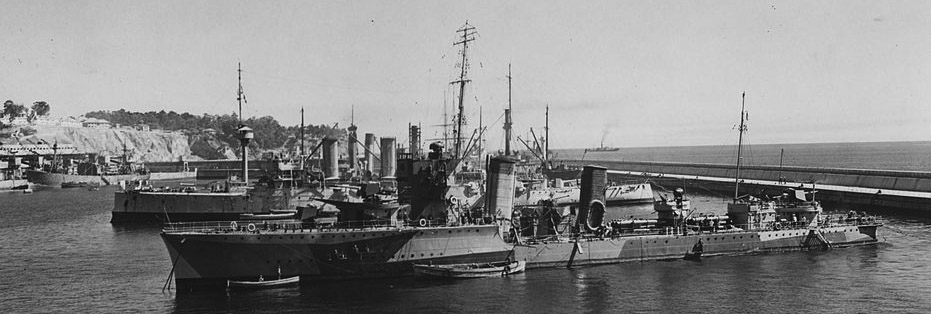
A camouflaged Serrano at anchor, date uncertain, perhaps in WW2. Chilean ships stayed camouflaged postwar as well.
On that chapter the situation was not that bad. Thanks to the only interwar naval plan, Chile had the Serrano class destroyers, six 1928-launched, British built (Thornycroft) destoyers somewhat modelled on the new Type A standard. With four main guns and two torpedo tubes banks, they were still relevant in 1945, albeit lacking radar. They were kept as long as possible until new destroyers were provided, pruchased from the US. Thus, they were discarded gradually between 1957 and 1967 for the last one, CNS Serrano.
Submarines
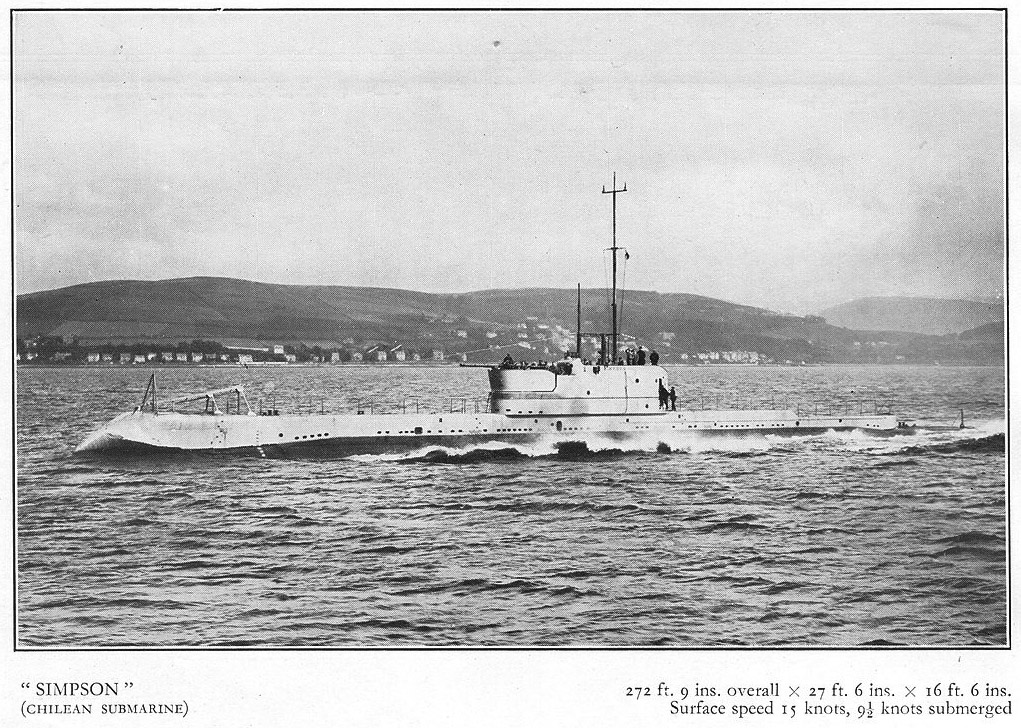
On that chapter, the situation was a bit less rosy. With the appearance of the Type XXI in 1944, WWI sub designs seemed a lost cause. Chile still had three 1917 British-built subs, Fresia, Guacolda and Guala (364/435t) which were essentially Vickers Holland II types. Status was uncertain, but they were discarded in 1949 and 1953.
In better shape were the three Capitan O’Brien class, built in Britain as part of the same naval plan seeing the destroyers construction. They were typical of the time and modelled after the Odin class, with the caracteristic main gun mounted high in the conning tower. It does no appear thay had any upgrades or modernization over the years. They were simply replaced when new Oberon class were purchased, in 1957-58.
1946-47 acquisitions
Frigates acquisitions (1946)

This part is more interesting. In 1946, both Canada and Britain were getting on masses of civilian-built ASW vessels, namely River class frigates and Flower class corvettes. They were sold almost at steel weight price, all equipped and a bounty for all 2nd-3rd rank navies willing to expand their navies on a budget. Chile obtained three of each class:
Covadonga, Esmeralda and Iquique (River class) of Canadian construction (Esmeralda class), with Esmeralda being renamed Baquedano to free the name in 1952. They had a SU radar and type 144 sonar, but no other modernization. All three served until 1968.
Second were three Flower class (Casma class): Casma (ex-Stellarton), Chipana (ex-Strathroy) and Papudo (ex-Thorlock). Also unchanged, they had stock type 271Q or type 273 or type 291 radar, type 144 sonar. Chipana was employed as survey ship. They were discarded in 1967-69.
Misc. Vessels
In addition the Chilean Navy also gained a sizeable amphibious fleet, there again based on the bounty of surplus vessels, this time in the USN inventory.
-Four LSMs (“Aspirante class”)
-Six LCICs (Cabo Bustos class)
-Eight numbered LCPs
-Twenty Tow LVCPs
-Two LCPLs
It seems they were already worn out and were discarded from 1958 onwards, the last in 1967.
As a footnote, Chile also acquired three ex-US Tugs patrol crafts (Lautaro class). They were scrapped in 1986.
There was also the submarine depot ship Araucano (1929). She was discarded in 1962.
History of the Chilean Navy 1947-90
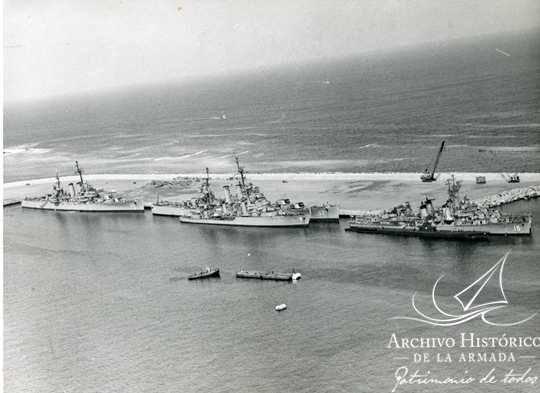
Destroyers Cochrane and Blanco Encalada, Fletcher class, light cruiser O’Higgins, destroyer Almirante Riveros and light cruiser Capitán Prat in Arica port, circa 1965.
Tensions always has been there as the country has been beset by domestic and international problems, and difficult relations with Argentina, having a long standing border and contested shares waters far south, with fishery control and oil deposits discovered in a contested area. In fact Chile has a problem with oil and the country had a token part of the national demand through indigenous production. Relations with Peru have been strained since the War of the Pacific (1879-83), when Chile crushed Peru. The significant increase in strength of the Peruvian Navy vis-à-vis that of Chile in recent decades has added to the pressure upon the Chilean Navy. Thus, today the Chilean Navy faces reputedly strong fleets to both the north and south.
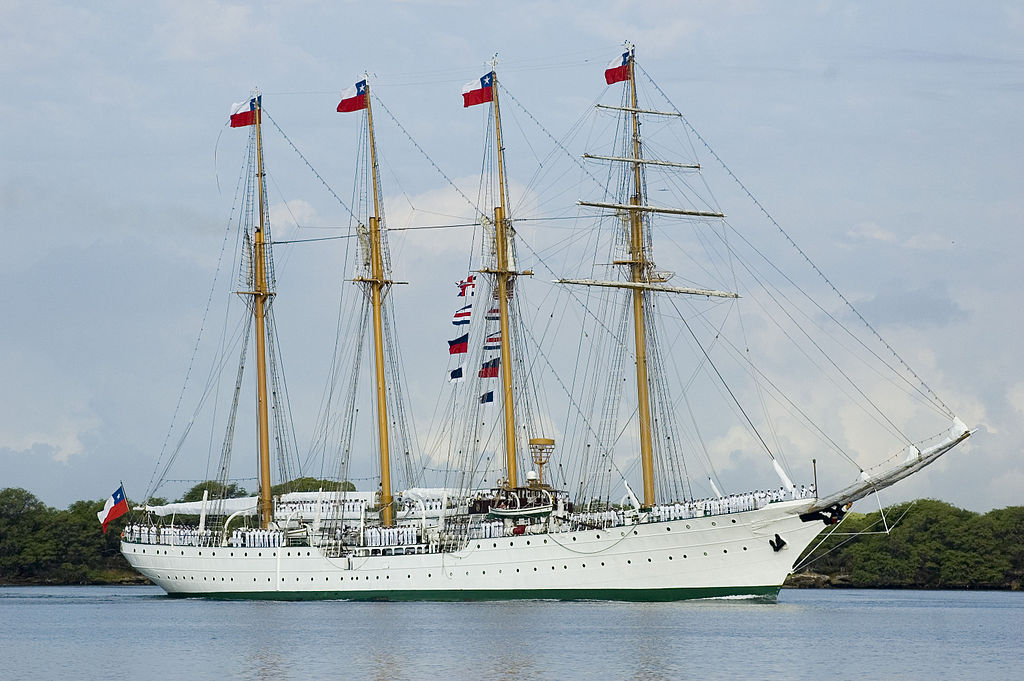
Chile formulated its Antarctic claim in 1940 and by 1947, now reinforced by the frigates and corvettes seen above, plus aphibious vessels, it established its first base, (Captain Arturo Prat) on the continent. That was before the two other bases estiablished by the Chilean Army or Air Force, but navy retained a major role in supplying these three Chilean bases. It also rescued the MV Explorer in 1972 and 2007. The Navy also gained a new ambassador, replacing the Battleship Latorre: The sailing-school ship Esmeralda, which began operations in 1952, making world cruises with selected cadet officers and NCOs as requirement for graduation. There was also previously a much older sailing ship, General Baquedano, which was preserved.
In the 1950s, the Chilean Navy took part in several border incidents with the Argentine Navy, and Argentine civilians on the Beagle Channel and Cape Horn. These were mostly incursions into Chilean waters by Argentine fishing ships. This went awry when a a Chilean lighthouse was briefly shelled by Argentine ships, known as the Snipe incident by 1958.
By the late 1970s, the Chilean Navy was well present as well around the Picton, Lennox and Nueva islands, also conveted by Argentina. This was before the Falklands, but well into this wave of nationalistic claims.
Chile’s international problems, which directly affect the navy, do not end here.
After the 1973 Chilean coup d’etat, in wich participated the Army, Air Force, Carabiniers, but also the navy led by Admiral Jose Toribio Merino, a government junta led by Augusto Pinochet was setup. After resigning in 1981, Admiral Merino became chairman until March 199, and he was also the national defense minister. Esmeralda, from an admired ambassador around the world became a floating prison with a torture chamber for political prisoners in 1973–1980 with perhaps c100 kept there at times. Long after the junta was ousted from power, old specter of this era resurfaced, and this tarnished the reputation of the sailing barquentine when she resumed her “tall ships” tours. The junta era however saw an unprecedented period of growth and expansion for the Navy. Anf both the marines and a newly created special forces weree considerably strengthened.
The fall of the Allende government in 1973 however had strained United States-Chilean relations to breaking point. Thus, the major supplier of warships and spare parts to Latin America has cut off Chile. This impacts very heavily on the maintenance of the Fletcher class destroyers and other US-built ships in the Chilean fleet. The reactivation of the cruiser O’Higgins in 1978 and the submarine Simpson in 1977 evidenced the need for fleet units. Also, Chile had been unable to purchase new warships from abroad or to secure a bi-national construction agreement as Argentina and Peru have done.
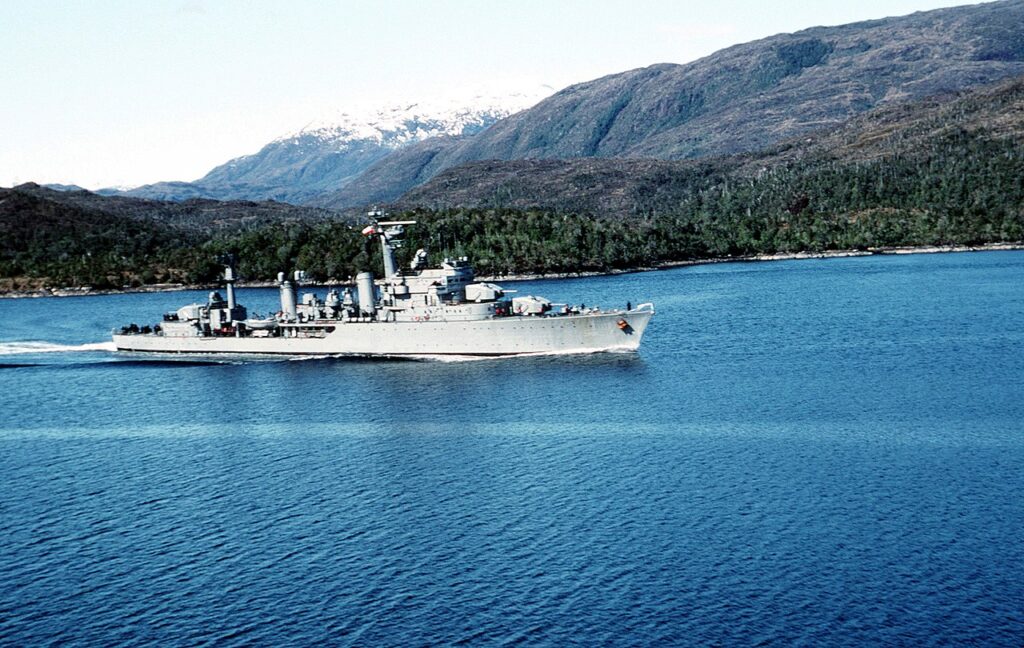
Almirante Williams underway close to the Tierra del Fuego
During the Falklands War, the Chilean fleet was moved south to add pressure to the Argentine Navy, after a multiplication of incidents over the decade. Chile’s acquisition problems in the early 1980s in contested waters led Chile to order two Type 209 submarines, built three small landing ships under bi-national construction agreement with France. During the 1980s the Chilean Navy managed to acquire four ex-British County class guided missile destroyers, its far lagest assets for decades. These very seaworthy ships well suited for the harsh conditions around the Chilean coasts, acting as flagships for smaller destroyers and frigates. Their acquisition made it possible to retire the old cruiser O’Higgins (ex-Brooklyn) which has become a museum ship in the USA.
During 1982, there were persistent rumours that the British carrier Hermes was on offer to Chile for transfer after her final commission in the Royal Navy but these came to nothing. For many decades the Chilean Navy, unit for unit, has been reported to be the best in Latin America. Evidence suggests that every effort is being made to retain this quality. Soon, however, the adverse material position of the navy must have an impact.
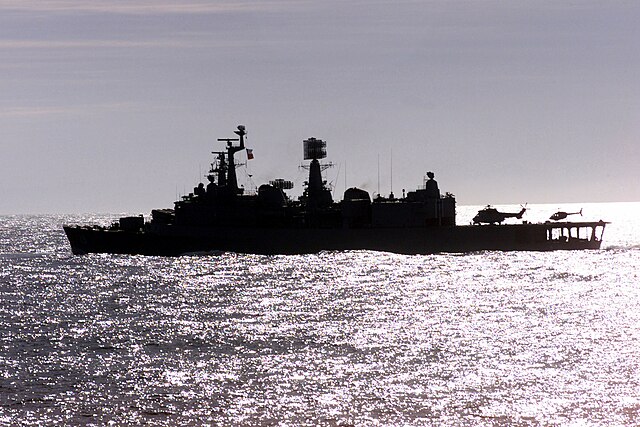
Guided Missile Destroyer Almirante Blanco Encalada (D15) in the 1990s.
Organization of the Chilean Navy
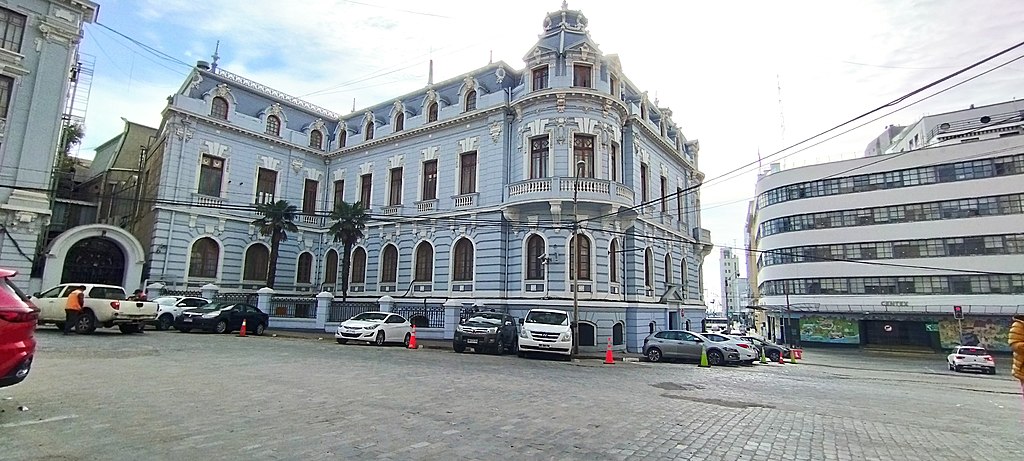
Old Armada de Chile HQ in Valparaiso
Institutions: Naval Academy and Command
Naval educational institutions were reformed in 1968 so to allow president Eduardo Frei Montalva to create a corp of “Naval Specialities Schools System” headquartered at Las Salinas Naval Base, Viña del Mar. Also the Naval Seaman Training School became the Seamen’s School “Captain Alejandro Navarrete Cisterna” during its centenary, and it became the Naval Polytechnic Academy in 1995 after a merger of all component schools, albeit retaining their independent constituent academies.
The main Atlantic naval base is at Talcahuano where there is also a major repair yard. This Talcahuano base also houses the four submarines and their tender ship. Other bases are Puerto Montt, Punta Arenas (Strait of Magellan and Tierra del Fuego), Iquique and Puerto Williams (Cape Horn and Drake Passage). And of course Valparaiso. In 1995 personnel numbered 22,800 including 2000 officers and 5000 Marines. Conscription is for a 12-month period.
Chilean Marines (Infanteria de Marina de Chile)
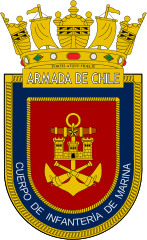 The birth of the modern Chilean Marine Corps started in 1964. The Cuerpo de Infantería de Marina de Chile was in reality created in 1817, but it was reorganized, reequipped and expanded massively in 1964. The Chilean Marines are now organized into two battalion detachments (Destacamento de Infantería) and two full-time battalions plus support units, ramped up to a full division formation of 2 brigades plus independent units as of today.
The birth of the modern Chilean Marine Corps started in 1964. The Cuerpo de Infantería de Marina de Chile was in reality created in 1817, but it was reorganized, reequipped and expanded massively in 1964. The Chilean Marines are now organized into two battalion detachments (Destacamento de Infantería) and two full-time battalions plus support units, ramped up to a full division formation of 2 brigades plus independent units as of today.
The Expeditionary Amphibious Brigade (Brigada Anfibia Expedicionaria, BAE), is its amphibious component tasked of support for peacekeeping missions and war operations on all terrains, headquartered in Concon and Talcahuano. It comprised the 21st Marine Battalion “Miller”, 31st Marine Battalion “Aldea”, 41st Marine Combat Support Battalion “Hurtado” and 51st Marine Logistic Battalion. The two remaining Marine Detachments and independent are tasked of the protection of national territory and naval bases: The 1st Marine Detachment “Lynch” (Fort Condell, Iquique) and the 4th Marine Detachment “Cochrane” at Río de los Ciervos. In addition Each zone has a “Naval Detachment of Order and Security”, acting as Marine MPs. In total this is a 5,000 man force today.
As for vehicles, the Chilean Marines operates as of today the following, bu acquisition order:
–FV101 Scorpion light tank (1993) 12, and 15 more in 2008, so 32 total.
-M-973 Tracked articulated vehicles (1998), useful in winter and antarctic, assembled in Chile at Cardoen.
-M1151/M1152 HMMWV (2008): Unknown numbers, partially transferred to the Carabineros when replaced by the French PVP.
-LAV III (NZLAV) (2022), 22 second hand from New Zealand, possibly to replace the Piranas (see below).
-Kia KLTV181 (2022), an order currently has been placed to South Korea, unknown numbers. Comparable to the Hummers.
It is completed by a fleet of trucks (mostly Korean), Kia KM 420 and M998 HMMWV tactical vehicles, quads and motorcycle for the spec-ops.
In the past, it’s possible the Marines operated or were leased from the army the domestic Cardoen Famae Pirana as their main armoured component.
The Chilean Naval Air Force

It’s comprising the following:
6 EMB 110 Bandeirante (acquired 1976-79), 4 today
8 P-3 Orion (6 second-hand 1993, 2 P-3A, 6 UP-3A transport), 2 mod. 2019-2021 by IMP Aerospace today.
3 C-295 Persuader purchased from EADS CASA in 2007 (1 today).
7 Partenavia P.68 Italian Recce/utility Observer purchased from Vulcanair in 2015 (2 today).
3 EMB 110C Bandeirante (Transport) acquired in 1975 (1 today).
7 German Bo 105 Bölkow (UH-05) early 1990s (4 today)
5 AS332 Super Puma for ASuW/ASW/utility
9 AS365 Dauphin (HH-65) SAR, second-hand, 4 200-2006, 4 2008, last 2021.
5 AS350/H125 (HH-50) Écureuil Acquired in 2019-2023.
10 Pilatus PC-7 Turbo Trainer 8 in 1980, 2 in 1981. 7 today.
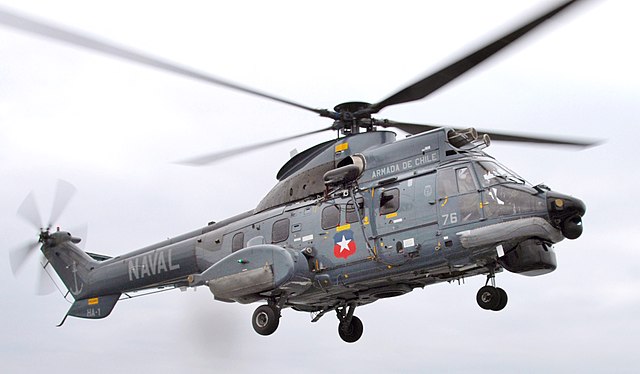
Post-1995 decades and Future Plans
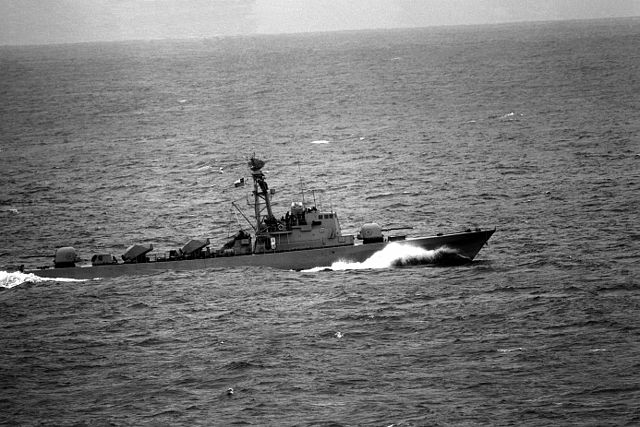
Sa’ar 4 type ship of the Chilean Navy
The Chilean navy grew to 25,000 personal (including 5,200 marines), under Admiral Julio Leiva Molina Martin as of 2017. It was expanded to 66 surface vessels, and then 74, with some 21 “major combatants” based in Valparaíso. The Navy managed to obtained an independent air branch from the air force, operating its own transport and patrol aircraft for transport, patrol, and surface and antisubmarine attack.
The navy also provides access to services for residents of Chile’s Pacific and Southern island regions, thus integrating its disjointed geography. The transport of passengers, especially during the school year or in cases of emergency, together with the supply of provisions and fuel, are of key importance to the inhabitants of these insular zones.
The institution regularly carries out civil operations whereby navy professionals provide social assistance and health care to the civilian population, and provide support in cases of natural catastrophe. It also undertakes preventive education campaigns for Chile’s population on issues that include security on beaches and seaside resorts, and measures to be taken in the case of a tsunami.
The most important naval bases and supply depots are (from north to south) in the Pacific Ocean: Iquique, Easter Island, Valparaíso, Talcahuano, Puerto Montt; in the Atlantic zone: Strait of Magellan and Tierra del Fuego: Punta Arenas, in the Beagle Channel, Cape Horn and Drake Passage: Puerto Williams, and in Antarctica: Captain Arturo Prat Base. These are now spread into five naval zones.
2000s fleet :
In the 2000s, the Chilean Navy started to completely change face, reorganized around frigates and submarines, plus OPVs and a sizeable amphibious branch.
8 Frigates
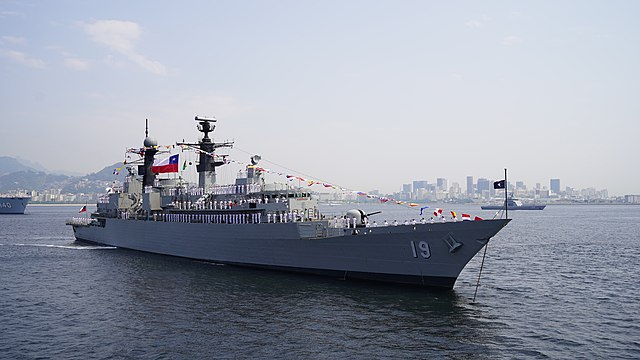
Type 22 Frigate, Almirante Williams at the Rio de Janeiro naval review, 2022.
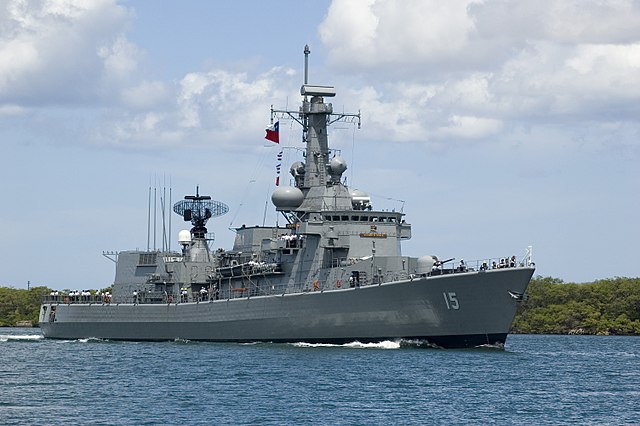
Almirante Blanco Encalada, Doorman class
Single Type 22 (Broadsword): CNS Almirante Williams (FF-19) 2003
Four Type 23 (Duke class): Almirante Cochrane (FF-05) 2006, Almirante Lynch (FF-07), Almirante Condell (FF-06) in 2006-2008
Two Adelaide class: Almirante Latorre (FFG-14), Capitán Prat (FFG-11) in 2020
Karel Doorman class: Almirante Blanco Encalada (FF-15) 2005.
4 Submarines
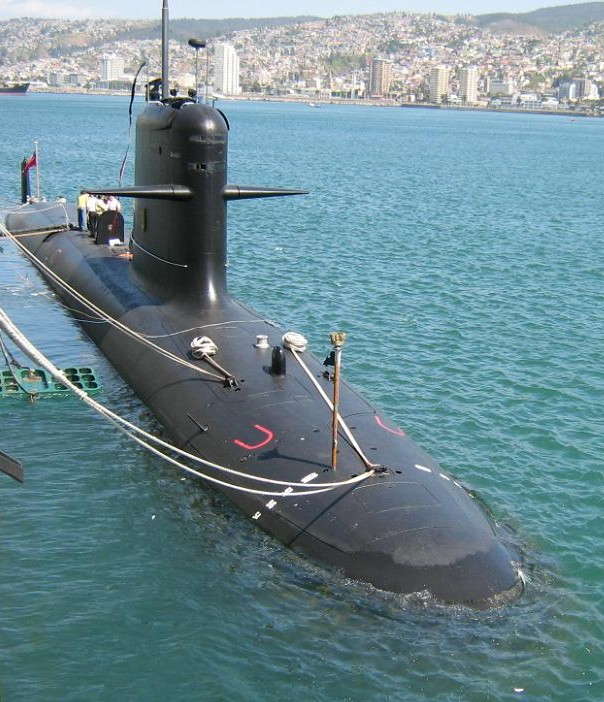
Scorpène class (DCN Cherbourg/IZAR): O’Higgins (SS-23), Carrera (SS-22), 2005-2006
Thomson class (Type 209/1400-L): Thomson (SS-20), Simpson (SS-21) 1984 (still in service, pending modernization).
Small surface Combatants
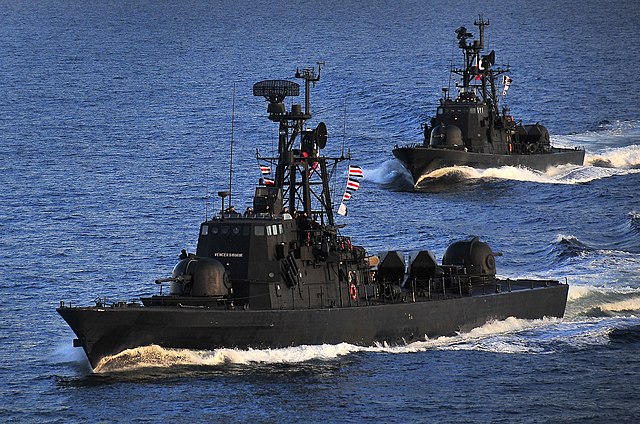
PV-80 class: Piloto Pardo, Comandante Toro, Marinero Fuentealba, Cabo Odger OPV-81-84 (2017)
Taitao class: Contramaestre Micalvi, Contramaestre Ortiz, Aspirante Isaza, Piloto Sibbald (1996)
Sa’ar 4 class FACs: Reshef clas: Casma, Chipana, Angamos 1979, 80, 97.
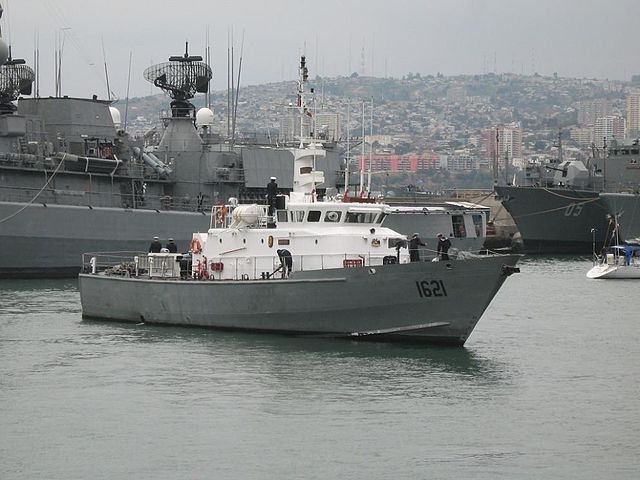
Protector class: Aysén, Corral, Concepción, San Antonio, Caldera, Antofagasta, Arica, Coquimbo, Puerto Natales, Valparaíso, Punta Arenas, Talcahuano, Quintero, Chiloé, Puerto Montt, Iquique, Ona, Alacalufe, Hallef: All CPBs built at ASMAR, Talcahuano 1999-2004.
Dabur class: Grumete Díaz, Salinas, Machado, Hudson (1990-95)
Type 44 SPB: Pelluhue, Arauco, Chacao, Queitao, Guaiteca, Curaumilla (2001)
26 Archangel-class PBs. 13 tons maritime patrol/rescue services 2008-2014.
31 Defender-class PBs (4.2 tons) 2007-2012, 2018-2020 co-produced US company, design ASMAR, Valparaíso.
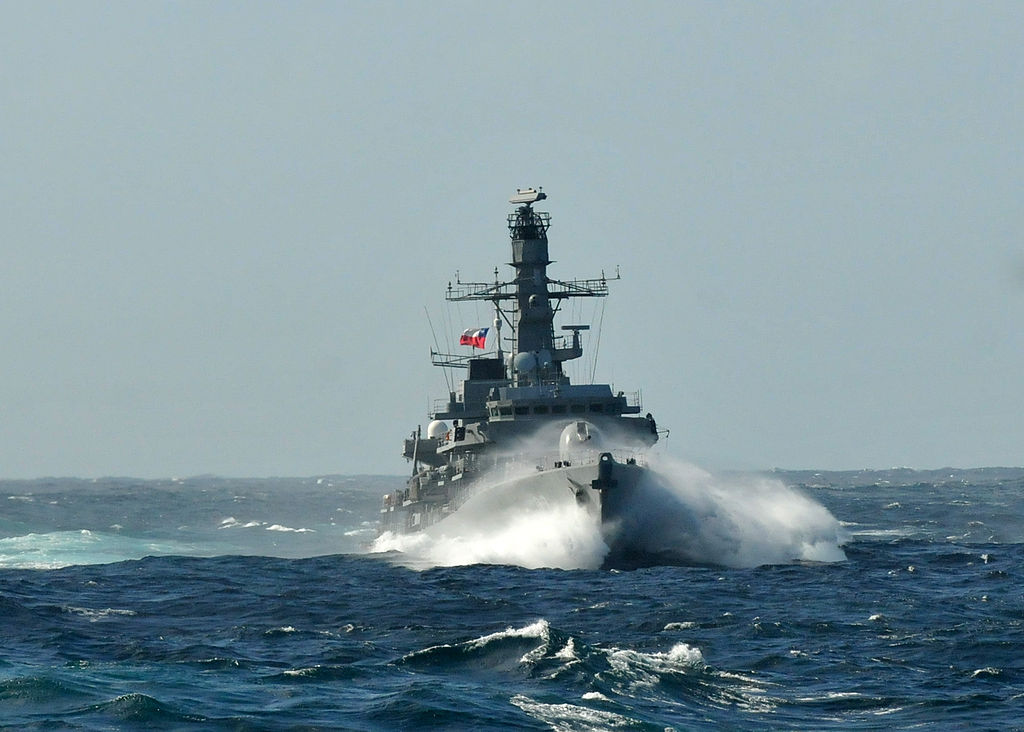
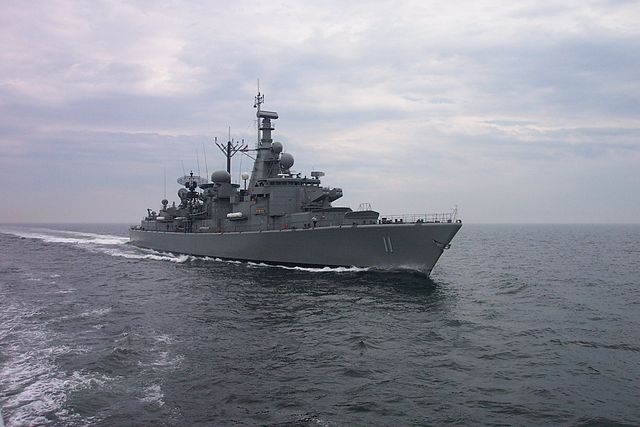
Capitan Prat, of the Doorman class
Amphibious ships
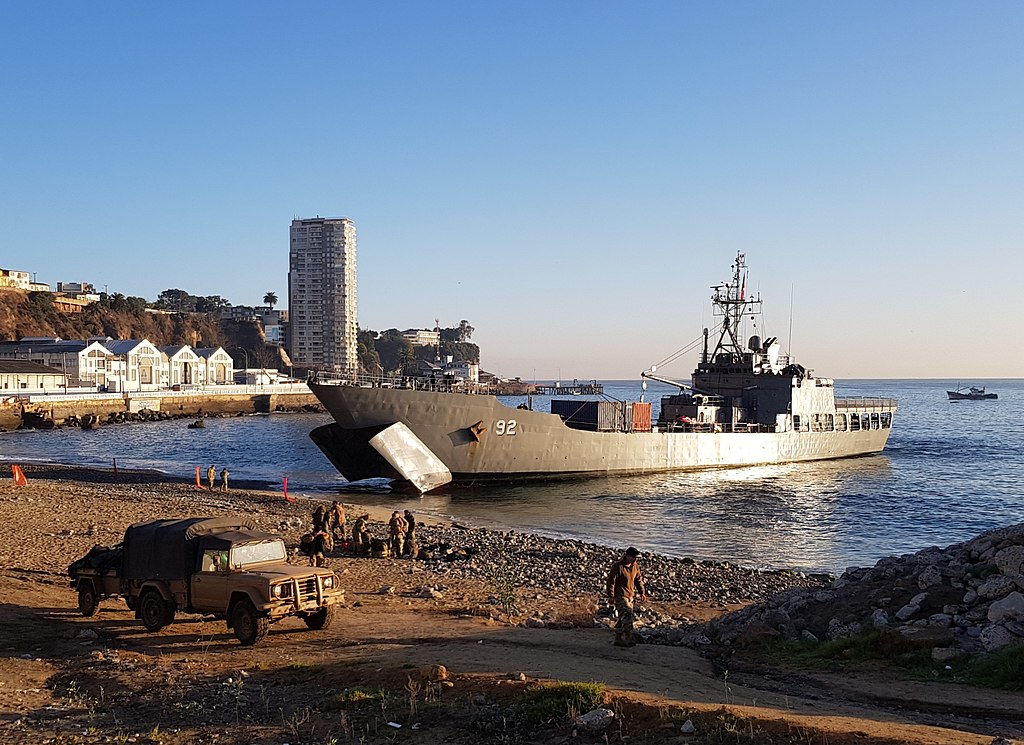
Foudre class: Sargento Aldea (LSDH-91, acquired 2011)
BATRAL class: Rancagua, Chacabuco LST-92 , 95: 1983-75 (ASMAR, Talcahuano)
Orompello class: Elicura (LSM-90), 1968 (ASMAR), scheduled for replacement.
Misc. ships
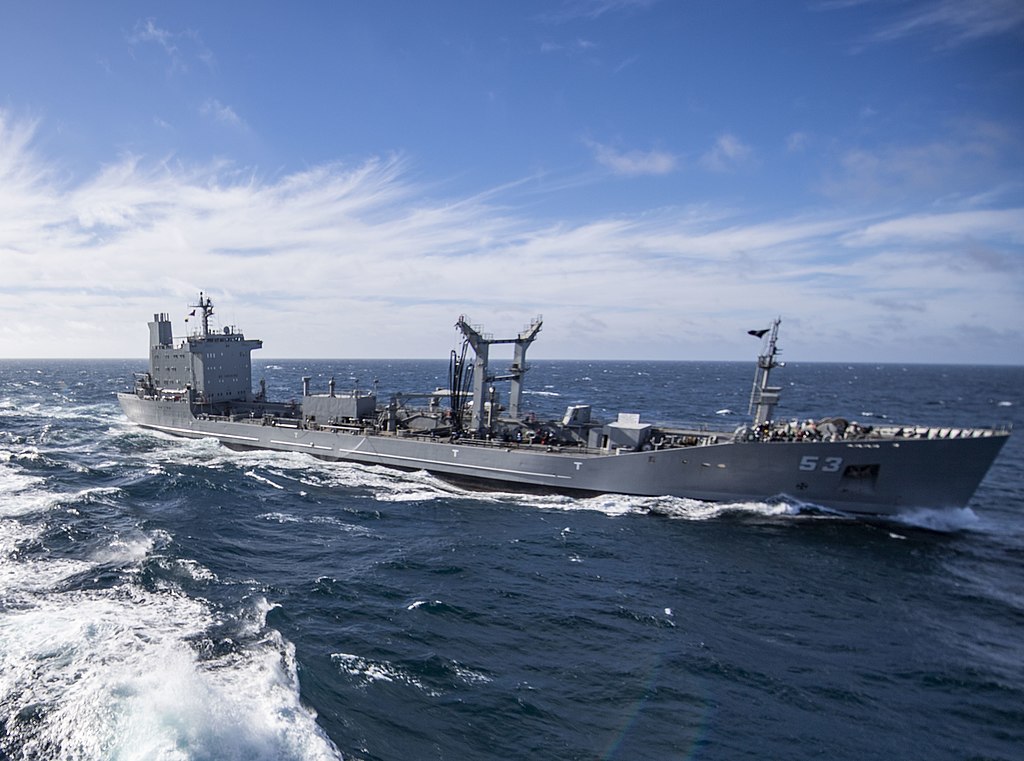
-Cabo de Hornos (AGS-61, 2013) Oceanographic ship from ASMAR
–Taitao class: Corneta Cabrales PSH-77 (1996) Hydrographic patrol ship from ASMAR
–Ingeniero Slight: Rescue and salvage vessel BRS-63 (1997), Buoy tender from B.V.J. Pattje Scheepswerf NL
Future Navy acquisitions:
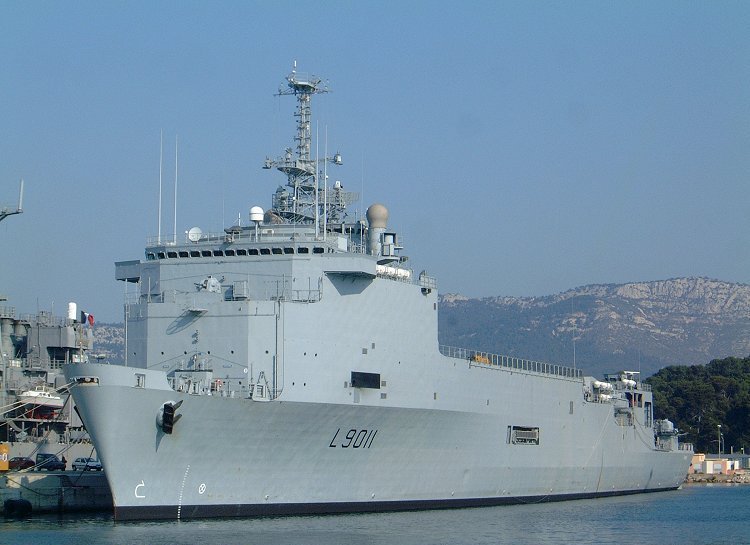
One valuable, recent Amphibious is the landing ship Foudre. Construction PZM “Patrulleros de Zona Marítima” (PZM) for each naval zone is planned.
The Chilean Navy also testing drones, like the Elbit Hermes 900 unmanned aerial vehicle, under prolongated evaluation. It is planed to replace or modernize the Leander class frigates and by December 27, 2019, it was announced that Australia sold the Adelaide-class frigates, HMAS Newcastle (FFG 06) and HMAS Melbourne (FFG 05) to Chile as well, rounding the total to eight.
The amphibious force has not been forgotten, hence the Construction of four multi-purpose ships (LPD), part of the project “Escotillón IV” and “plan de construcción naval continua”.
The latter is a cooperation agreement between Sernapesca and the Navy to operate the Pumar inspection boat model WR1250 Explore by ASMAR in Valparaíso. This is one of the latest acquisitions in 2020.
Read More/Src
https://en.wikipedia.org/wiki/List_of_current_equipment_of_the_Chilean_Marine_Corps
http://www.navypedia.org/ships/chile/chi_es.htm
https://en.wikipedia.org/wiki/List_of_active_ships_of_the_Chilean_Navy
Nomenclature of Chilean Ships
 O’Higgins class cruisers (1951)
O’Higgins class cruisers (1951)
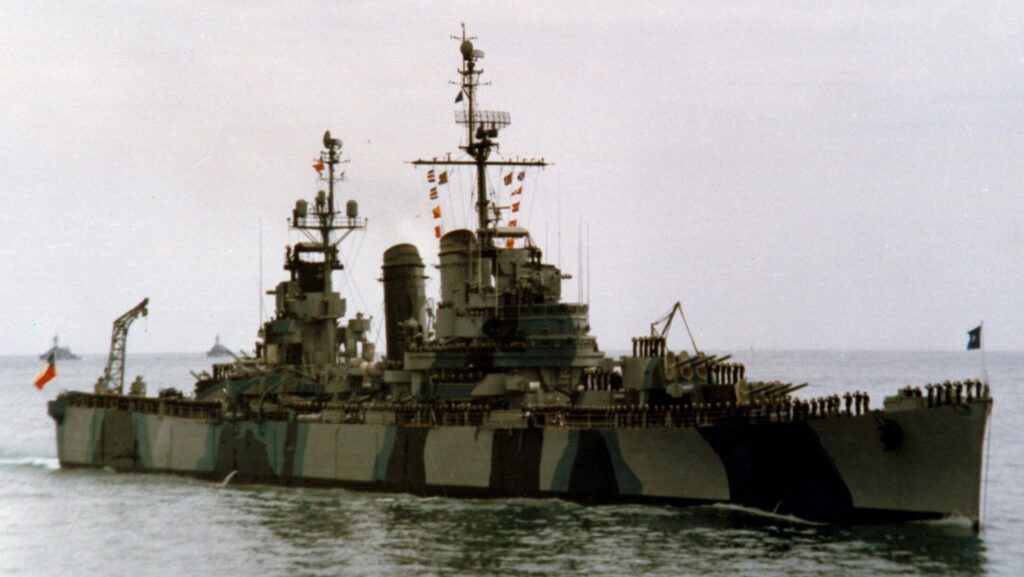
The most spectacular acqisition of the Chilean Navy in the early cold war were a pair of Brooklyn class cruisers: O’Higgins (ex-Brooklyn) and Capitán Prat (ex-Nashville) (from 1982 Chacabuco). Albeit the design of these ships went back to 1935, they were groundbreaking for US cruiser design at the time, and had be throughly modernized in WW2. Their key feature was a battery of fifteen rapid-fire 6-in guns in three triple turrets. Both were acquired for $37m apiece (10% of the original cost) at the time she ships has been decommissioned, and a contract for transfer led to a limited refreshing overhaul. The final transfer was done on 9 January 1951. They would be active until after the Falklands war. Same type as ARA General Belgrano and Nueve de Julio, both Chile and Argentina had a pair of similar cruisers.
As delivered both had five triple 6-in/47 Mk 16 guns, eight single 5-in7/25 Mk 27 guns (not as good as the later DP /38) and four quad 40mm/60 Mk 2 Bofors, six twin 40mm/60 Mk 1, nine twin 20mm/70 Mk 24. More importantly, they had a relatively modern radar suite, the SPS-4, SPS-6 search radars, and the Mk 13 and two Mk 28 fire control radars.
However this suite showed its age by the late 1950s and an agreement for modernization led to an important refit in 1957-59:
Armament: Six quad 40mm/60 Mk 2 (2 more) two twin 40mm/60 Mk 1, six twin 20mm/70 Mk 24, landing pad aft and Jet Ranger helicopter.
Electronics: SPS-10 and SPS-12 radars installed. The FCS were unchanged.
O’Higgins was grounded on 12.8.1974 in Patagonia fjords. Towed back to port but never fully repaired, she became an accommodation hulk, then was extensively refitted and fully recommissioned in 1978. She was decommissioned in January 1991 and sold 10.1991. Her sister did not have any improvements and was decommissioned in May 1982, and sold in April 1983. And oddity in the 1980s, O’Higgins was camouflaged.
 Latorre (1971)
Latorre (1971)
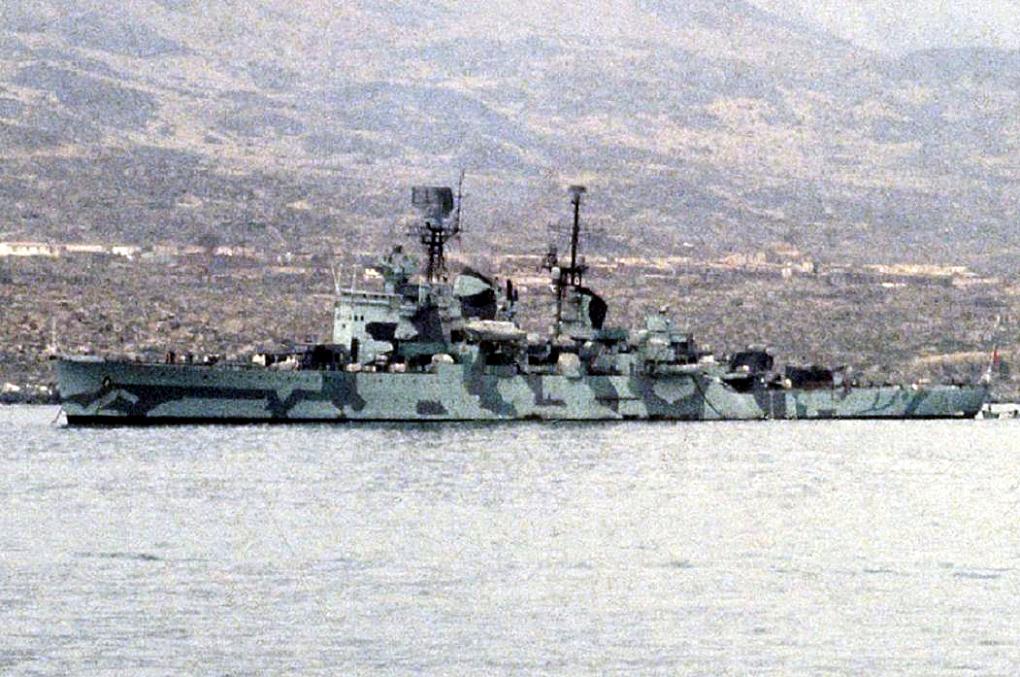
Also camouflaged, the ex-Göta Lejon, CNS Almirante Latorre.
The second and last important ship acqusition, at least on the prestige standpoint, was the ex-Swedish Navy Tre Kroonor class cruisers.
The Cruiser in 1964 had still a modern radar guided AA artillery and electronics suite but she was put up for sale. There were proposals studied by the commission in charge from 1965 to 1970. Eventuall an agreement was struck on 25 August 1971 with the Chilean Government. The transfer was done and by September 18, the Chilean flag was raised as Almirante Latorre. She departed European waters for the Cape Horn by 9 December 1971 and stayed in service for more than a decade, until February 4, 1984. Stricken and disposed of in August 1985, sold for scrapping to Taiwanese shipbreakers. When transferred and until decommission she had the following:
Armament: Triple and two twin 152mm or 6-in/53 M42 main guns, four single 57mm/60 M50 Bofors AA guns, 11 single 40mm/70 M48 Bofors, two triple 21-in TTs, capacity for 120 mines and four DCR.
Electronics: LW-03, type 277, type 293, fire control radars
 Almirante class destroyers (1960)
Almirante class destroyers (1960)
DDG-18 Almirante Riveros, DDG-19 Almirante Williams

Chile wanted a new destroyer class in the early 1950s and went to Britain for designs. Vickers and Thornycroft competed but the former design was chosen. It was announced on January 1954, the contract was finalised in 1955. They were built by Vickers, Barrow in Furness in 1960. This gave the yard an occasion to create destroyers which by armament and electronics (largely Netherlands Marconi sensors) were in advance of the contemporary Daring class. Their internal layout was modelled however on the Battle class. A successful design, they served until the 1990s. They sported quite a unique Vickers 4-inch dual purpose naval gun, single barrel, and capable of 50 rpm. These were better than the RN 4.5-inch guns, full automated yet more reliable but not water-cooled. This model was initially rejected by the RN on doubts of sustained firing and still large stocks of surplus 4.5 and 4-inch guns. Both were modernized in Britain in 1975.
A second pair was considered by the mid-1960s but two Condell-class frigates (Leander) were purchased instead.

Quickspecs: Disp. 2,730lt standard, 3,300 lt FL, 122.5 x 13.1 x 4 m (401 ft 11 in x 43 ft x 13 ft 1 in). Propulsion 2 × Babcock & Wilcox boiler, 2x Parsons geared turbines 54,000 hp, 34.5 knots, Range 6,000 nmi. Crew 266 (17 officers)
Armament: 4× 4 in Vickers Mark Q, 5× 40mm/70 Boofrs, Seacat SAM (1964), 1×5 21 in TTs, 4 ×Exocet SSM 1975, 2 × Squid ASW mortars, 2×3 324 mm ASW TTs (1975).
Electronics: Plassey ASW-1, 2x SGR-102 radars, type 184B sonar.
 Blanco Encalada class destroyers (1963)
Blanco Encalada class destroyers (1963)
Blanco Encalada, Cochrane
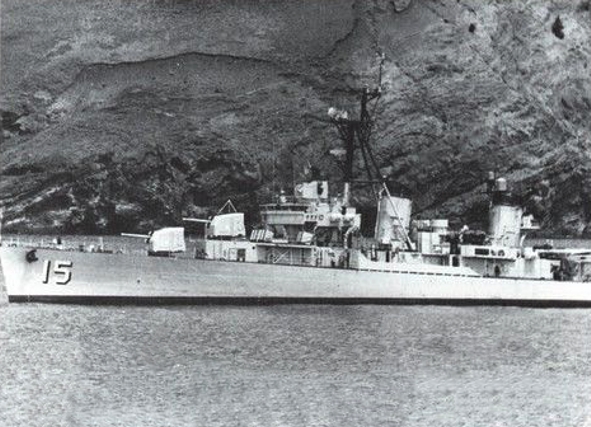
Almirante Cochrane (D-15) during UNITAS XV in 1974
Two ex-Fletcher class destroyers, ex-USS Wadleigh and Rooks as Blanco Encalada and Cochrane acquired in 1963, to replace the last of their 1930 Serrano class destroyers. They were of the modernized DDE type, with new electronics (SPS-6, SPS-10, Mk 25, Mk 34 radars, QCJ sonar) and four 5-in/38 guns but also three twin 3-in/50, single TT bank, two Hedgehogs, Two DCR, Two K-Guns. Initially more planned for transfer but former escort destroyers were instead in 1966. In the end they were good complement to the British Almirante class. No modernization, discarded 1982, replaced by new missile destroyers while the British Almirante were modernized.
 Orella class escort destroyers (1966)
Orella class escort destroyers (1966)
Serrano, Orella, Riquelme, Uribe
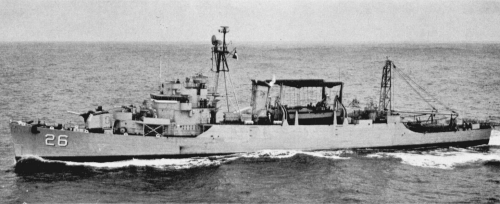
Instead of additional Fletchers, for the same price it was more affordable to acquire four DDEs, which was done in 1966. But these were converted as fast transports (APD) in WW2 and thus were specialized in amphibious warfare, a good complement to the surplus amphibious crafts purchased in the late 1940s. Class: Serrano (ex-Odum), hulk 6.1984; Orella (ex-Jack C. Robinson), hulk 10.198; Riquelme (ex-Joseph E. Campbell) stricken 3.1982; Uribe (ex-Daniel T. Griffin), same.
 Ministro Zenteno class destroyers (1974)
Ministro Zenteno class destroyers (1974)
Ministro Zenteno, Ministro Portales
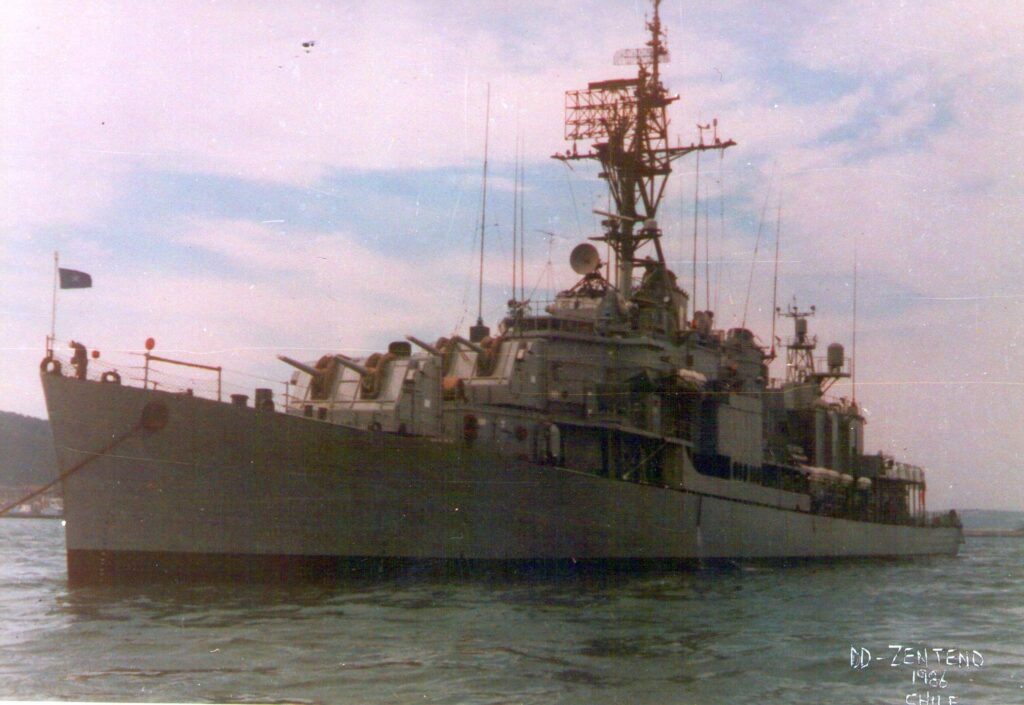
Ministro Zenteno in 1986 (Navsource)
As part of the 1974-75 modernization plan of the Chilean Navy, two more ex-US destoyers were purchased, this time FRAM II standard Allen M. Sumner class destroyers: Ministro Zenteno (ex-Charles S. Sperry) stricken 1990 and Ministro Portales (ex-Douglas H. Fox) same. As delivered they had three twin 5-in/38 Mk 38 guns, two 20mm/70 Mk 10, two triple 324mm Mk 32 TT Mk 44, 2x 24/178 Hedgehog Mk 11 ASWRL, but they operated a Chilean Alouette III. Electronics consisted of the SPS-29, SPS-10, Mk 25 radars, SQS-40 sonar with towed array, WLR-1 ECM suite.
 Prat class destroyers (1982)
Prat class destroyers (1982)
Capitán Prat, Almirante Cochrane, Almirante Latorre, Almirante Blanco Encalada

Certainly the best all-around missile destroyers of the Chilean Navy. Long story short, fuelled by increasing tension with Argentina, Chile decided as part of the 1974 modernization to acquire missile destroyers. For financial reason this was only concluded in 1982, when tensions rose high. An agreement was concluded with the RN to sell four decommissioned County class destroyers: Capitán Prat (ex-Norfolk, retired 7.2006), Almirante Cochrane (ex-Antrim, retired 11.2006), Almirante Latorre (ex-Glamorgan, spare source 12.1998) and Almirante Blanco Encalada (ex-Fife, DO 12.2003). They diverged between them: Three were armed with four MM38 Exocet SSM (4 MM38), a twin Sea Slug Mk 2 SAM (30 Sea Slug), two quad Sea Cat GWS22 SAM (8 Sea Cat), a twin 120mm/45 Mk 6 turret, two 20mm/70 Mk 7, and carried a single helicopter BO-105CBS. And there was Almirante Blanco Encalada (D 14), which had no Sea Cat SAM, two 40mm/60 Mk 7 Bofors instead. Same helicopter BO-105CBS but a larger hangar and longer landing deck aft, going to the stern (illustration below).
Electronics: Type 978, type 965M AKE-2, type 992Q, type 277, type 901, type 903, 2x 904 radars, type 184, type 162 sonars, UA-8/9, type 667 ECM suites, 2x Corvus decoy RL, ADAWS-1 CCS.

 Leander type Frigates (1970)
Leander type Frigates (1970)

First modern frigates acquired by the Chilean Navy in order to replace the WW2 Canadian-built River/Flower described above. Four ex-Leander class were acquired from Yarrow, Scotstoun, built on purpose and generally similar to their RN sisters. Laid down in 1967 to 1971, comp. 1970-74. Class:
-Ministro Zenteno (ex-Achilles D 08) (1968), retired 2006
-General Baquedano (ex-Ariadne D 09) (1971), deactivated, kept for spare parts 12.1998
-Almirante Condell (D 06 1972). retired 2007, sold to Ecuador as Presidente Eloy Alfaro.
-Almirante Lynch (D 07 1973) retired 2007, sold to Ecuador as Morán Valverde.
The former had a quad Sea Cat GWS22 SAM (12), twin 120mm/45 Mk 6, triple 305 Limbo Mk 10 ASWRL, 1 Wasp helicopter
The latter had 4x MM38 Exocet SSM, same but two twin 20mm/70 Mk 24, two triple 324mm ASW TT, and a BO-105CBS helicopter.

Unlike british ships they had taller foremasts and their Exocet MM 38 were on the fantail.
Upgrades: Almirante Condell, Almirante Lynch in the late 1980s had two twin MM40 Exocet SSM, type 1006, type 966 radars, NS-9003A, NS-9005 ECM suites plus the helicopter deck and hangar enlarged for an AS.332B Super Puma helicopter. Later they obtained the SP-100 CCS. Lynch in 2006 received a 20mm/76 Mk 15 Phalanx CIWS and Mk 90 radar to guide it.
Ministro Zenteno was modernized in 1996, with two single MM38 Exocet SSM and the type 966, type 992Q radars, NS-9003A, NS-9005 ECM suites.
 Thomson class subs (1961)
Thomson class subs (1961)

These were two ex-Balao class, CNS Simpson (ex-Spot 5.1944) a single GUPPY III on 23.1.1961 and stricken in 1982 and Thomson (ex-Springer, 8.1944) transferred on 12.1.1962 in “stock” conditions and kept for spares for her sister on 9.1972. She had SS, ST, SV radars, WFA, JT sonars, APR-1 ECM suite and amazingly she kept her 5-in/25 Mk 40 gun aft of the CT. Her sister Thomson kept her Bofors AA gun, until retired in 1977.
 O’Brien class subs (1972)
O’Brien class subs (1972)
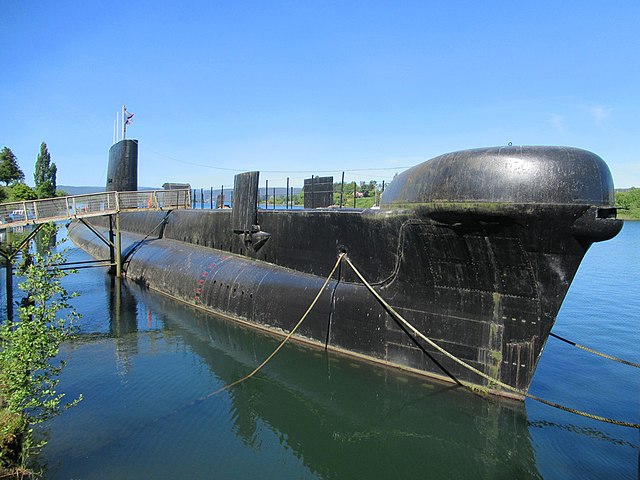
Two ex-Oberon British conventional attack submarines. They were O’Brien (S22, 1972), transferred 15.4.1976 and Hyatt (S23 1973) both from Scott-Lithgow, Greenock, transferred 27.9.1976, stricken 3.2003 and 4.2000. Planned fo a July 1974 completion which was delayed to redo internal cabling. Similar to the regular Oberon class they had 6 TTs, 22 torpedoes, and later upgraded with the Atlas Elektronik CSU 90 suite and BAC Type 2007 flank array. Originaly they had the type 1006 radar, type 2007, type 187, type 197, type 719 sonars, Porpoise ECM suite, Mk 2, Mk 4 Mod.1B torpedo decoy launchers.
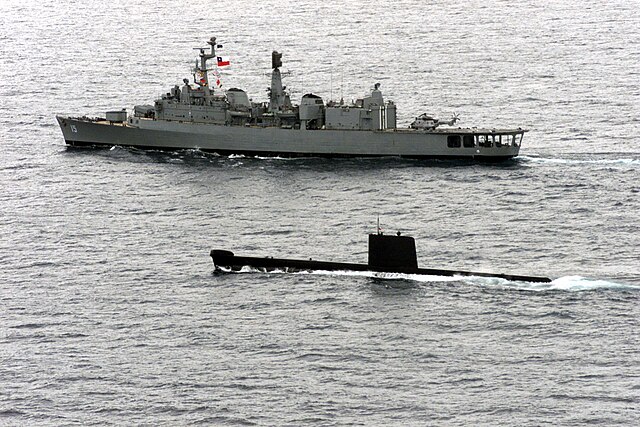
 Thomson(ii) class subs (1982)
Thomson(ii) class subs (1982)
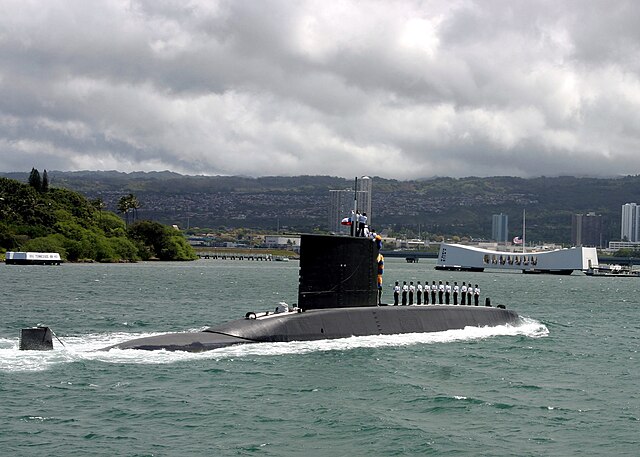
SS20 Thomson entering Pearl Harbor for a naval review, 21 June 2004.
Modern attack submarines from Howaldtswerke, Kiel, West Germany, Type 209/1400C design with some tailorisation: Sail and masting 0.5m higher than other ships to cope with higher wave off the Chilean coasts, escape hatches fitted in the torpedo and engine room, additional aft hatch in the sail with access to the machinery.
Thomson (SS20) launched 28.10.1982, comp. 31.8.1984 and Simpson (SS21) launched 29.7.1983, comp. 18.9.1984. Both are still in service. Two more were projected in 1988, but not funded. Originally they had the Calypso II radar, CSU-3 sonar suite, PRS-3/15 sonar, DR-2000U ECM suite. In the early 1990s this was upgraded for both to a Sinbad CCS. In 2012 for Simpson and 2013 for Thomson they received a major upgrade new 21-in bow tubes to fire SSMs, 16 torps, 4 SM39 Exocet SSM, A-184 Black Shark, SUT types. Electronics upgraded to the SUBTICS sonar suite (TSM2233 Mk 2, TSM2253 sonars), and SUBTICS CCS, satnav. The Chilean Navy expects them to serve until the 2030s.
 Chilean Amphibious Fleet
Chilean Amphibious Fleet
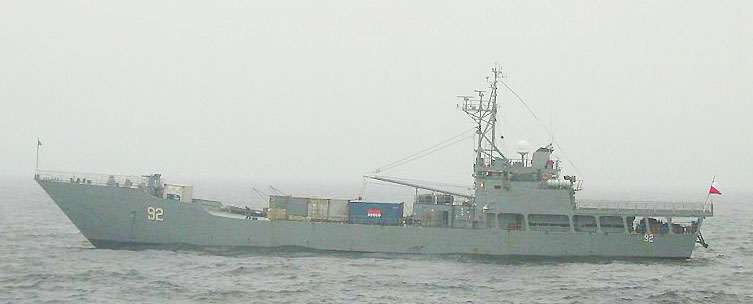
Rancagua, Batral type.
WW2 stock ships:
Four Fast assault destroyers (LPD, Orella class)
ISAZA medium landing ship (1947-1960) or “aspirante”, 4 USN LSM class
ÁGUILA tank landing ships (1964-1973) four USN LST class. Águila was the former ARV(E)3.
6 LCICs (Cabo Bustos class), 8 LCPs, 22 LVCPs, 2 LCPLs.
PRESIDENTE PINTO amphibious cargo ships (1945/1946): US built Presidente Errázuriz (ex-Xenia) and Presidente Pinto (ex-Zenobia), ww2 AKA type
ANGAMOS amphibious cargo ship (1941/1946) merhantman from Aalborg vaerft, Denmark comp. for the Chilean Navy.
Cold war vessels
MAIPO medium landing ships (1982-1986) three modern ships, BATRAL class, from ASMAR, Talcahuano: Rancagua, Chacabuco LST-92 , 95
VALDIVIA tank landing ship (1971/1995) or Orompello class: Elicura (LSM-90), 1968 (ASMAR), scheduled for replacement.
SARGENTO ALDEA landing platform dock (ex-Foudre, completed 1990, transferred 2011)
PILOTO PARDO amphibious transport (1959): Antarctic ice-reinforced polar research and transport ship from Haarlemsche SM, Netherlands (1957).
AQUILES amphibious transport (1953/1967): Former Danish Aalborg vaerft transport converted in Chile
AQUILES(ii) amphibious transport (1988): Tailored ASMAR, Talcahuano ship (1987) with helicopter hangar and large cargo bay.
 Small Surface Combatants
Small Surface Combatants
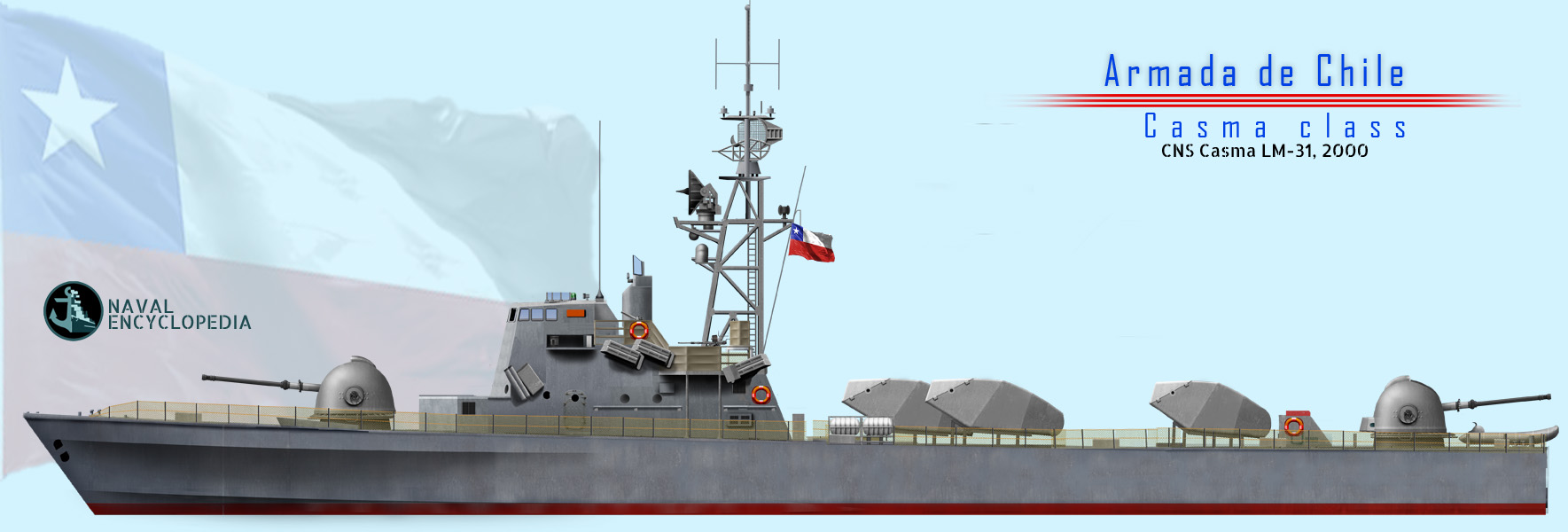
CASMA class FAC (missile) (acquired 1997): Ex Saar 4 Casma (ex-Romach), Chipana (ex-Keshet), Angamos (ex-Reshef), Papudo (ex-Tarshish).
IQUIQUE class FAC (missile) (acquired 1989): Earlier Sa’ar 3 class boats from CMN Cherbourg, Iquique (ex-Hanit) and Covadonga (ex-Hetz), both discarded in 2000.
GUARDIAMARINA RIQUELME class FAC (missile) Four former West German Type 184/La combattante from Lürssen, Vegesack and CMN, acquired 1997-1998: Guardiamarina Riquelme, Teniente Orella, Teniente Serrano, Teniente Uribe, Stricken 2012-2017.
GUACOLDA class fast attack craft (torpedo) 1965-1966. Four Lürssen design, built at Izar, San Fernando, Spain: Guacolda, Fresia, Quidora, Tegualda. Camouflaged for the Beagle Channel. Stricken 2001-2007.
PAPUDO class sub chasers (1971). From US PC1638 type from ASMAR, Talcahuano: Papudo only (Pisagua and Abtao cancelled). Also Contramaestro Ortiz (no info).
 Coast guard ships
Coast guard ships
MARINERO FUENTEALBA class large patrol craft (1966-1967): Fishing boat hulls by ASMAR: Marinero Fuentealba, Cabo Odger. stricken 1999
PILLAN patrol boats (1979-1982): 10 Brazil-built (Niteroi wooden boats): Pillan, Troncador, Rano-Kau, Villarrica, Corcovado, Llaina, Antuco, Osorno, Choshuenco, Copahue. Discarded 1998-2002.
ONA class patrol boats (1980): Ona, Yagan from ASENAV, Valdivia, LEP1601, 1602. Discarded 2001.
ALACALUFE class patrol boats (1989): Alacalufe, Halef from ASMAR, Talcahuano, in service as of 2022.


 Latest Facebook Entry -
Latest Facebook Entry -  X(Tweeter) Naval Encyclopedia's deck archive
X(Tweeter) Naval Encyclopedia's deck archive Instagram (@navalencyc)
Instagram (@navalencyc)





 French Navy
French Navy Royal Navy
Royal Navy Russian Navy
Russian Navy Armada Espanola
Armada Espanola Austrian Navy
Austrian Navy K.u.K. Kriegsmarine
K.u.K. Kriegsmarine Dansk Marine
Dansk Marine Nautiko Hellenon
Nautiko Hellenon Koninklije Marine 1870
Koninklije Marine 1870 Marinha do Brasil
Marinha do Brasil Osmanlı Donanması
Osmanlı Donanması Marina Do Peru
Marina Do Peru Marinha do Portugal
Marinha do Portugal Regia Marina 1870
Regia Marina 1870 Nihhon Kaigun 1870
Nihhon Kaigun 1870 Preußische Marine 1870
Preußische Marine 1870 Russkiy Flot 1870
Russkiy Flot 1870 Svenska marinen
Svenska marinen Søværnet
Søværnet Union Navy
Union Navy Confederate Navy
Confederate Navy Armada de Argentina
Armada de Argentina Imperial Chinese Navy
Imperial Chinese Navy Marinha do Portugal
Marinha do Portugal Mexico
Mexico Kaiserliche Marine
Kaiserliche Marine 1898 US Navy
1898 US Navy Sovietskiy Flot
Sovietskiy Flot Royal Canadian Navy
Royal Canadian Navy Royal Australian Navy
Royal Australian Navy RNZN Fleet
RNZN Fleet Chinese Navy 1937
Chinese Navy 1937 Kriegsmarine
Kriegsmarine Chilean Navy
Chilean Navy Danish Navy
Danish Navy Finnish Navy
Finnish Navy Hellenic Navy
Hellenic Navy Polish Navy
Polish Navy Romanian Navy
Romanian Navy Turkish Navy
Turkish Navy Royal Yugoslav Navy
Royal Yugoslav Navy Royal Thai Navy
Royal Thai Navy Minor Navies
Minor Navies Albania
Albania Austria
Austria Belgium
Belgium Columbia
Columbia Costa Rica
Costa Rica Cuba
Cuba Czechoslovakia
Czechoslovakia Dominican Republic
Dominican Republic Haiti
Haiti Hungary
Hungary Honduras
Honduras Estonia
Estonia Iceland
Iceland Eire
Eire Equador
Equador Iran
Iran Iraq
Iraq Latvia
Latvia Liberia
Liberia Lithuania
Lithuania Mandchukuo
Mandchukuo Morocco
Morocco Nicaragua
Nicaragua Persia
Persia San Salvador
San Salvador Sarawak
Sarawak Uruguay
Uruguay Venezuela
Venezuela Zanzibar
Zanzibar Warsaw Pact Navies
Warsaw Pact Navies Bulgaria
Bulgaria Hungary
Hungary

 Bundesmarine
Bundesmarine Dutch Navy
Dutch Navy Hellenic Navy
Hellenic Navy Marina Militare
Marina Militare Yugoslav Navy
Yugoslav Navy Chinese Navy
Chinese Navy Indian Navy
Indian Navy Indonesian Navy
Indonesian Navy JMSDF
JMSDF North Korean Navy
North Korean Navy Pakistani Navy
Pakistani Navy Philippines Navy
Philippines Navy ROKN
ROKN Rep. of Singapore Navy
Rep. of Singapore Navy Taiwanese Navy
Taiwanese Navy IDF Navy
IDF Navy Saudi Navy
Saudi Navy Royal New Zealand Navy
Royal New Zealand Navy Egyptian Navy
Egyptian Navy South African Navy
South African Navy






























 Ukrainian Navy
Ukrainian Navy dbodesign
dbodesign